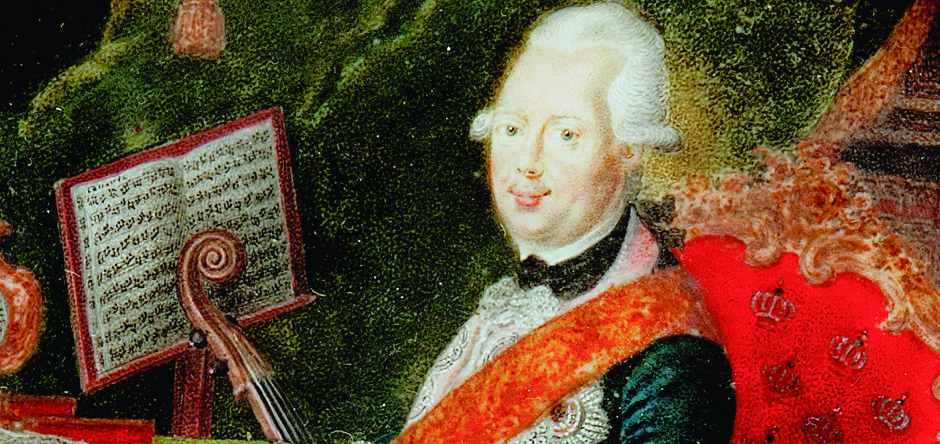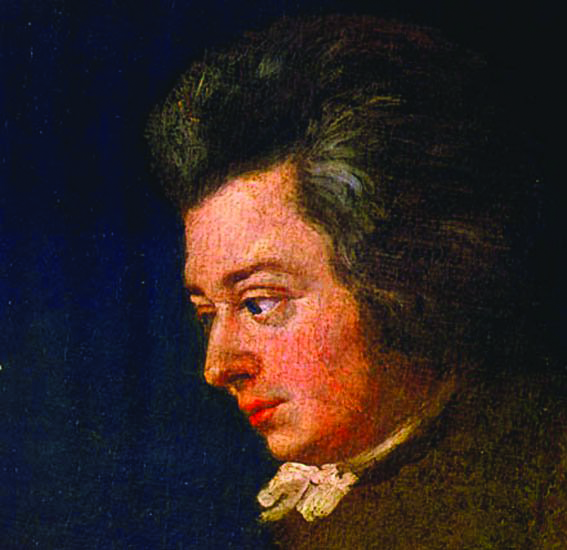QUARTET IN B-FLAT MAJOR, K. 589 (PRUSSIAN)
Wolfgang Amadeus Mozart (b. Salzburg, Austria, January 27, 1756; d. Vienna, December 5, 1791)
Composed 1790; 24 minutes
 As a patron of music, Frederick the Great, the music-mad monarch, who even found time to play the flute on the battlefield, was a hard act to follow. But his nephew, Friedrich Wilhelm II (1744-97), rose to the challenge. His chosen instrument was the cello and he had a passion for string quartets and quintets. A skilled performer, Friedrich Wilhelm had almost 2,500 documented instrumental parts in his library. One year after taking over the Prussian throne, he appointed Luigi Boccherini his court composer. Other fine performers obtained positions at his court. Haydn dedicated his Op. 50 quartets to him. Ignaz Pleyel followed with no less than 12 quartets. Other composers also tugged at the royal purse strings, naturally favoring the cello in the music they proffered.
As a patron of music, Frederick the Great, the music-mad monarch, who even found time to play the flute on the battlefield, was a hard act to follow. But his nephew, Friedrich Wilhelm II (1744-97), rose to the challenge. His chosen instrument was the cello and he had a passion for string quartets and quintets. A skilled performer, Friedrich Wilhelm had almost 2,500 documented instrumental parts in his library. One year after taking over the Prussian throne, he appointed Luigi Boccherini his court composer. Other fine performers obtained positions at his court. Haydn dedicated his Op. 50 quartets to him. Ignaz Pleyel followed with no less than 12 quartets. Other composers also tugged at the royal purse strings, naturally favoring the cello in the music they proffered.
In the spring of 1789, Mozart set his sights on a position at the Prussian court or at least a commission from the King. Legend (and many history books) have it that after the three-month trip, which included Leipzig, Dresden, Berlin and Prague, Mozart returned to Vienna a disappointed man. He had with him a small amount of money and a commission to write what he described a year later in a letter to Viennese textile merchant Michael Puchberg as “six easy clavier sonatas for Princess Frederike and six quartets for the King.”
 Recent research, however, has revealed that it is by no means certain that Mozart was even received at King Friedrich Wilhelm’s court in Potsdam, and the commission for six quartets appears to have been a speculative venture by a composer who was hard pressed for cash. But composition of the quartets did not come effortlessly. One year after visiting Potsdam, Mozart was describing to Puchberg that what we now refer to as the three completed Prussian quartets were a ‘troublesome task.’ There are surviving false starts to all three finales and, for K. 589, a cancelled attempt for a minuet and a draft for a full (different) finale. This was all in keeping with Mozart’s self-imposed need for innovation. And it helps prove that this innovation was hard-won, no matter how fluent and effortless the quartets may strike us when listening two and a quarter centuries later.
Recent research, however, has revealed that it is by no means certain that Mozart was even received at King Friedrich Wilhelm’s court in Potsdam, and the commission for six quartets appears to have been a speculative venture by a composer who was hard pressed for cash. But composition of the quartets did not come effortlessly. One year after visiting Potsdam, Mozart was describing to Puchberg that what we now refer to as the three completed Prussian quartets were a ‘troublesome task.’ There are surviving false starts to all three finales and, for K. 589, a cancelled attempt for a minuet and a draft for a full (different) finale. This was all in keeping with Mozart’s self-imposed need for innovation. And it helps prove that this innovation was hard-won, no matter how fluent and effortless the quartets may strike us when listening two and a quarter centuries later.
K. 589 begins elegantly with the cello taking a prominent role in introducing the subsidiary themes. The lyrical upper register of the ‘royal’ instrument takes the lead in announcing the beautiful, arching theme of the slow movement. In the minuet, all four instruments play an equal part in a texture of unusual richness and subtlety, with particular attention – and not a few technical challenges – being directed towards the cello in the lively central trio section. Again, in the finale, all four instruments are woven equally into a closely argued discussion of unusual compactness.
